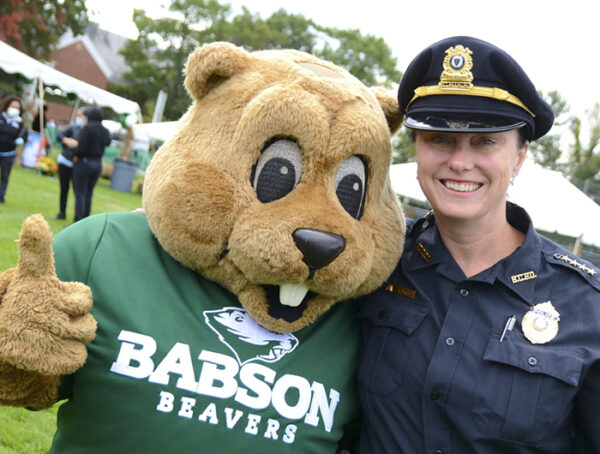Boosting the Number of Women in Law Enforcement

Babson College Chief of Police Erin Carcia experiences the subtle but potent positive impacts of women in policing and law enforcement every day.
Just this month, a new student employee asked to speak with Carcia privately. She had been watching and learning about the police chief’s role, and she wanted Carcia to know how inspiring it is to see a woman in charge.
“I got goosebumps,” Carcia said about the meeting.
“I think women bring different skill sets to the job. We bring different approaches and different strengths in general when dealing with the community,” Carcia said. “But, I also think that seeing women in policing roles and seeing that people can count on us in a crisis, that’s why it’s so important to increase the number of women throughout the criminal justice system.”
That’s why Carcia, who also serves as vice president of the Massachusetts Association of Women in Law Enforcement (MAWLE), is a key figure in promoting the group’s ambitious 30 by 30 pledge. The nationwide initiative aims to increase the representation of women in law enforcement agencies to 30 percent by the year 2030.
“One of our biggest values is making sure we’re getting to the forefront of representing women in our line of work,” Carcia said. “It’s not just law enforcement; it’s work throughout the criminal justice system. It’s figuring out how to embrace women and increase recruitment and retention.”
Carcia made a high-profile appeal for greater inclusion in policing during a mid-July ceremony as the Boston Police Department signed on to the 30 by 30 pledge.
“Currently, women make up only 12 percent of sworn officers and 3 percent of police leadership in the United States. This underrepresentation of women in policing has significant public safety implications and direct impact on the communities we serve,” Carcia said to an audience that included Boston Mayor Michelle Wu and Boston Police Commissioner Michael Cox.
“I want to reiterate on behalf of MAWLE this ceremony affirms that the Boston Police Department is taking the lead in being a role model for other police agencies and departments across the Commonwealth and we hope others will follow their lead.”
Inspire and Thrive
Carcia, who began working at the College in 2011, notes that Babson’s Public Safety Department recently hit the 30 percent mark, including several women in high-ranking roles such as sergeant and detective.
“I’ve been very fortunate that Babson actually has a lot of women at the leadership level,” Carcia said, listing examples such as Babson’s Chief Marketing Officer Kerry Salerno, Chief Administrative and Financial Officer Katherine Craven, and Vice President of Human Resources Donna Bonaparte. “These are really amazing, talented women, and when I see them around the table, it motivates me. It builds my confidence.”
As the first female police chief in Babson’s history, Carcia’s experiences navigating the male-dominated landscape of law enforcement have only fueled her determination to uplift other women within the field.

“When I got hired here 11 years ago, I was one of the only people with kids or small children. I was very self-conscious about it, because I wanted to make a good impression on the job,” Carcia said. “Now, we have other team members with families, which is fantastic, and they get leave, so now they’re seeing why we all need to help each other to prioritize our well-being and life work balance.”
The 30 by 30 pledge is not without its challenges, as it demands transformative changes in recruitment, retention, and advancement practices within law enforcement agencies.
Carcia acknowledged the complexities but emphasized the importance of collective efforts.
“We must work together to challenge stereotypes, address biases, and create more flexible policies that accommodate the unique needs of women officers,” Carcia said. “That’s how we attract and retain diverse talent and enhance the quality of our police services.”
Next Steps
Although 30 percent of Babson’s police department already is made up of women, Carcia plans on signing the 30 by 30 pledge soon so she can set an example for other police departments and continue the progress the BPD has made.
“I’m lucky here at Babson because I get support for not only recruitment and retention, but for professional development, training, and other ways to keep staff engaged,” Carcia said. “I’m excited to share with the community that our intention is to be formally in the pledge and to remain there and grow. There’s always more work to do.”
“Seeing women in law enforcement roles and seeing that people can count on us in a crisis, that’s why it’s so important to increase the number of women throughout the criminal justice system.”
Babson Chief of Police Erin Carcia
That work includes expanding diversity, equity, inclusion, and belonging any way she can, Carcia said.
“I think that my next step is to continue embracing the importance of diversity within our department,” Carcia said. “How do we expand beyond women and into different underrepresented populations?”
Groups such as MAWLE offer another important avenue of support, through mentorship, advocacy, and educational programs, to shatter barriers and create a more inclusive law enforcement community.
“By fostering a network of support, we can inspire more people to join and thrive in this profession,” Carcia said.




